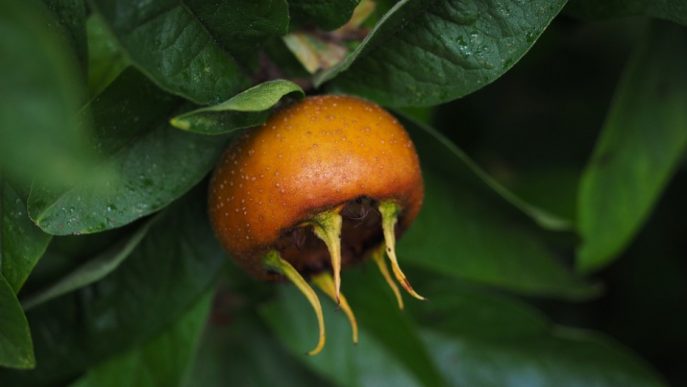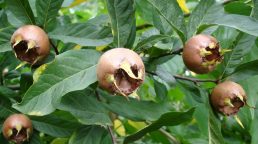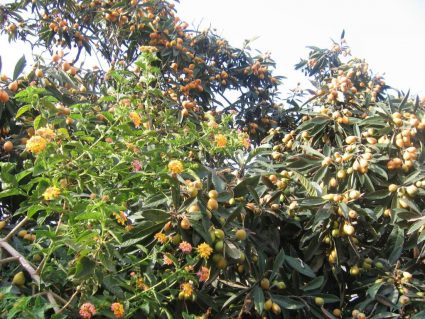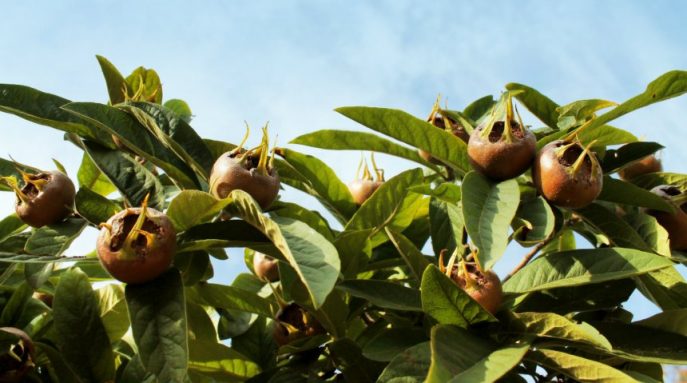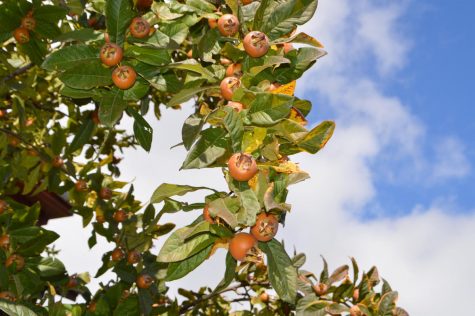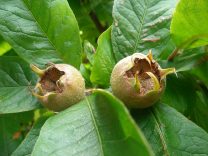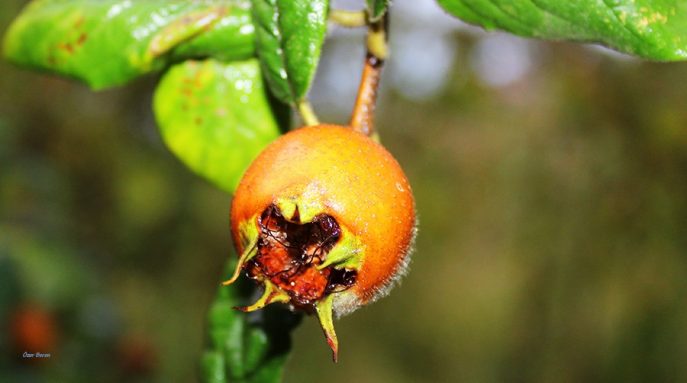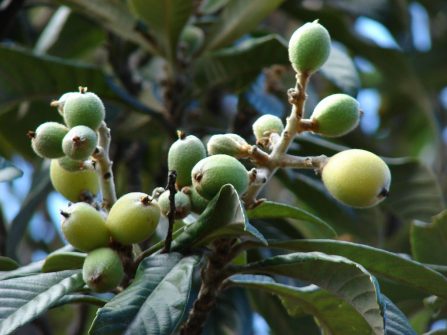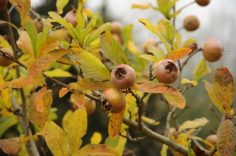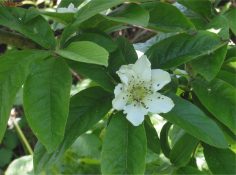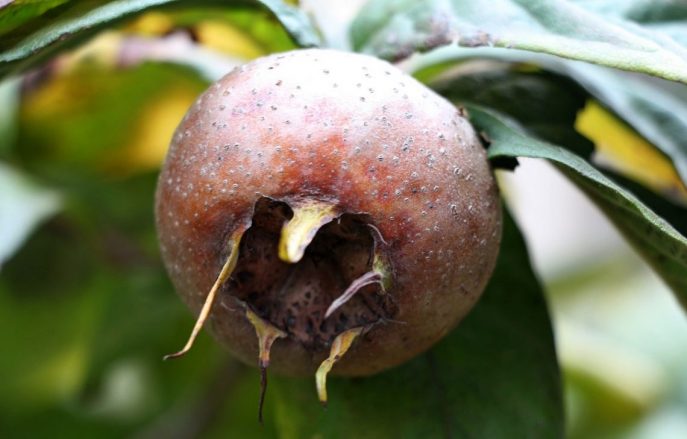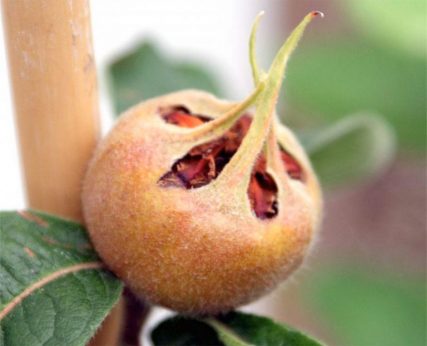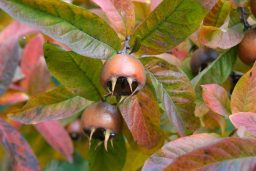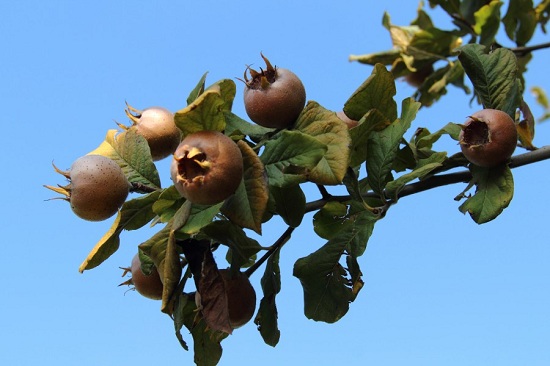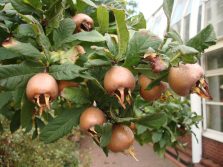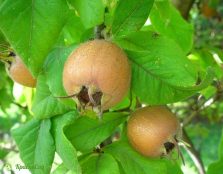For lovers of exotic, a beautiful sprawling tree with fragrant flowers in the spring and original fruits in the fall will be a good decoration of the garden - medlar German. Despite its subtropical origin, the culture is frost-resistant, rich in useful properties, not demanding in care, decorative, successfully survives in temperate regions.
Material Content:
German medlar: description of the species
The only representative of the species Mespilus germanica medlar German is the deciduous fruit tree of the family Rosaceae. A rather rare plant in our gardens, at home in Asia Minor, is everywhere found in the form of large trees up to 8 m high. In our latitudes, wild individuals can be found in the Crimea, the Caucasus (it is also called the Caucasian), in the Pre-Caspian region and the Baltic.
Introduced to Europe by the Romans, the German medlar reaches only 3 m, which allows it to be grown in small plots of land. The powerful root system is superficial. Spreading branches resembling a "weeping" willow, endowed with small spines, form a wide crown. This property must be considered when positioning in the garden.
The trunk of an adult tree is covered with gray-brown cracked bark, it reaches more than 15 cm in diameter. Medlar is a long-liver, the average duration is 40 years.
Decorative foliage attracts attention. Blooming pubescent young leaves grow up to 15 cm long and 3-4 cm wide, arranged on branches spirally. Blossoming leaves of dark green color with a pubescent underside turn purple in autumn, giving the tree sophistication.
The Caucasian medlar blooms in early spring, first white, then pinkish, similar to apple flowers, located at the ends of the shoots. Small 2-3 cm flowers exude the finest almond flavor.
In the autumn, a kind of reddish-brown hard fruits ripen 3-5 cm in diameter, with a thick skin that resembles a large rosehip. The pulp contains 5 seeds (this is the seeds). A specific tart flavor softens the frost, giving the fruit a sweetish taste.
German medlar has not only decorative qualities, but also numerous healing properties. For therapeutic purposes, all parts of the tree are used: fruits, leaves, bark, which do not lose their advantages during heat treatment.
Garden varieties of medlar German
Cultivation of the plant takes 3,000 years. There are some garden forms adapted for safe growing in temperate regions. Frost-resistant varieties can withstand temperatures down to -30 ° C, the most common: Sochi, Sweet Dracheva, Karadag, Khvamli.
Seedless varieties were also developed: Apirena with small fruits, the Huge Evreinova whose fruits reach 8 cm in diameter.
Bush-shaped forms are popular, for example, Dutch with large fruits (the size of an average apple).
All varieties are distinguished by the incredible taste and aroma of the fruit.
The plant tolerates the formation of crowns (pruning), thereby independently controlling the growth of the tree. The aesthetic shape of the tree is aesthetic.
The nuances of growing
The natural subtropical origin of the Caucasian medlar requires a sunny location, shading has a depressing effect on plant growth, but protection from a strong through wind will not be superfluous. Frosts are also not afraid of plants, if fresh shoots matured well, then winter shelter is not required, medlar can withstand -350 or more.
Medlar does not show any particular addiction to the composition of the soil, but vegetation is more successful on neutral or slightly acidic soils, where the occurrence of groundwater is more than one meter. The most favorable are super sandy, soddy, humus soils with an acidity of pH 5-6.
Garden planting is carried out in spring or autumn, depending on the climatic conditions of the region, in group plantings observing a distance between trees of 4 m, but the plant is self-pollinated, so only one tree is enough for fruiting, an important fact with a small area of the site.
Planting medlar in open ground
Given the preferences of the plant, the task of the gardener is to prepare a planting pit and soil for the seedling. In the selected sunny area you must:
- one month before planting, dig the soil in the region of 0.5 m in diameter, removing weeds, add bone meal or complex mineral fertilizer;
- drive a stake into the center of the circle, to which a seedling will subsequently be tied (a mandatory moment for growing a standard tree);
- dig a wide pit 1/3 more than the earthen clump of medlar;
- the tree is planted 5 cm from the stake, spreading the roots, carefully covered with nutrient soil;
- the earth is compacted, spilled with warm water.
The next day, the soil should be loosened and mulched using compost or rotted manure. With proper care, the tree (bush) will bear fruit for 3 to 4 years.
Plant care
The unpretentiousness of medlar does not require specific care, but it responds well with rapid growth to regular watering and top dressing. Timely pruning of the crown will add decorativeness and grooming to the tree.
Watering. The first 3-4 years of vegetation, regular watering, especially in dry periods, contribute to the branching of shoots. During flowering and fruiting, the frequency of irrigation can increase, it is desirable that the soil is moist all the time. Mulching the soil will help extend moisture.
Top dressing. A very important detail of the care, like all the large fruit trees, long-livers of medlar, depletes the ground near the root system, so for healthy vegetation it needs fertilizers. Need feeding three times a season.In early spring, a complex fertilizer with a predominance of nitrogen is introduced. You can use a solution of slurry (8: 1). During flowering and fruiting - with a predominance of potassium and phosphorus, for example, ash or nitrophos, they are fed with an interval of 3-4 weeks.
Pruning. Thickening of the crown will adversely affect not only the decorative qualities of the medlar, but also the healthy bearing. In the spring, all dry, painful, damaged branches are cut out, as well as for thinning the crown, so that unpromising branches do not interfere with fruiting. Experienced gardeners are advised to shorten the branches by half in the first 2-3 years.
The warm season and careful care of medlar seedlings contribute to the rapid, healthy growth of green mass and their readiness for fruiting.
Propagation of the German medlar
According to sources, the plant propagates both generatively (by seeds) and vegetatively (by layering, cuttings, grafting).
Seed way. Plants grown independently from the seeds become hardy, more adapted to the vicissitudes of the region's weather.
You can sow seeds directly into the ground in the fall. In spring, a large half of the seedlings appears. Do not rush to dig up the rest of the plot in a year, another 20% of the sprouts will appear, and in another year - 10%. The thick peel of the seeds must soften so that the sprout can break out. In winter, the seeds undergo a natural stratification, increasing vitality, acquiring frost resistance.
Medlar seedlings are grown at home. Bones are taken from fresh fruits (dry ones acquire a "shell", due to which the germination period increases). Before planting in the soil, the bones pass stratification by cold for 130 days. Placed in wet sand mixed with sawdust and peat, put down the refrigerator for 15 days, then transferred to a warm place for 15 days, and so on for the entire period. It is important to keep the soil moist.
Germination substrate must be nutritious, light, breathable.
For germination support:
- indoor air temperature not less than + 180 C;
- moderate but regular watering;
- enough light.
Take care of the seedlings in the same way as for any other seedlings. When the seedlings reach 20-30 cm of growth, they can be planted in open ground in autumn (southern regions) or in spring (northern).
Read also:planting and care, propagation of edible honeysuckle
Seedlings grown from seed retain all maternal traits.
Propagation by layering. You need to choose a healthy, flexible branch. Having made incisions in the cortex under the kidney, they bend the stem to the ground, where a small groove is dug. Press the branch with the incised side to the moistened soil, fasten with a V-shaped clip, sprinkle with earth, pour. Make sure that the soil is always moist, but without bays.
Layers grow roots and green mass within 2 - 2.5 years. The formed seedlings are separated from the mother plant, transplanted to a permanent place where they must grow until the end of life. The time of transplantation depends on the temperature regime of the region, it is recommended after falling leaves.
Cuttings. This method is used when it is not possible to get layering. From a healthy green branch cut at the time of flowering, cuttings with 2-3 internodes are cut at an angle of 450. Leaves are cut to half. Sections are disinfected. You can use crushed charcoal or "Kornevin."
Prepared cuttings are planted in individual containers with a large layer of drainage and nutritious light soil strictly vertically, deepened by 4-5 cm, watered. To create a greenhouse effect, cut plastic bottles or glass jars, or simply plastic bags, are used. For germination, place the containers in a warm place with a temperature of at least +180 - +200.
More than 3 weeks pass before new leaflets appear. All this time, daily airing of the “greenhouse” is necessary, watering as necessary. The appearance of the first leaf indicates rooting - the shelter is removed. Further seedling care consists only in regular watering.
In the spring, the young medlar is transplanted into the open ground to a permanent, pre-prepared place.
Graft. This method of reproduction is complicated, by virtue of experienced gardeners. Perform it before the sap flow begins. The stock for medlar is pears, quinces, hawthorn, they are more compatible, on the same tree they grow together without interfering with each other. Fans of experiments plant and plum, they say very tasty fruits are obtained.
Inoculation is carried out as an eye (budding), and the handle. The methods are also different: in a split or behind a bark.
German medlar is also used as a stock for pears.
It turns out compact trees that preserve space, with full-fledged pear fruits.
German medlar is grown at home. Forming the crown by cutting inhibited the growth of branches. During dormancy, the tree is carried to an unheated balcony or loggia. In the spring it is transferred back to the room. The self-pollination property helps to receive fruits in an enclosed space.
Diseases, pests and methods of dealing with them
The owners of this tree, growing it on their sites for many years, argue that medlar is practically not affected by pests and rarely gets sick.
Possible insect pests (aphids, scale insects) are destroyed by solutions of bioinsecticides (actophide, lepidocide).
From the attack of caterpillars devouring leaves, fumigation is saved: wet straw is sprinkled on top with tobacco dust, set on fire (care must be taken to prevent the straw from burning).
Fungal diseases (spotting, sooty fungus) arising due to excess moisture in rainy summers and autumn are sprayed with biofungicides (phytolavin, phytosporin, mycosan).
The ongoing prophylaxis with 3% Bordeaux liquid or other copper-containing solutions in the early spring (until the buds have blossomed) and in late autumn (after the leaves fall) will prevent the disease. The trunk, branches of the tree and the soil of the near-stem circle are processed.
Such preventive treatment is necessary for all neighboring trees and shrubs in the garden. Do not forget that fungal and bacterial diseases are transmitted by insects.
Medlar German unpretentious fruit tree that responds to attention and proper care by stormy spring flowering, enveloping the garden with a delicate aroma, decorative healthy foliage in the summer and many healthy fruits in the fall, able to maintain immunity, saturate with vitamins, alleviate many ailments of the owner.





